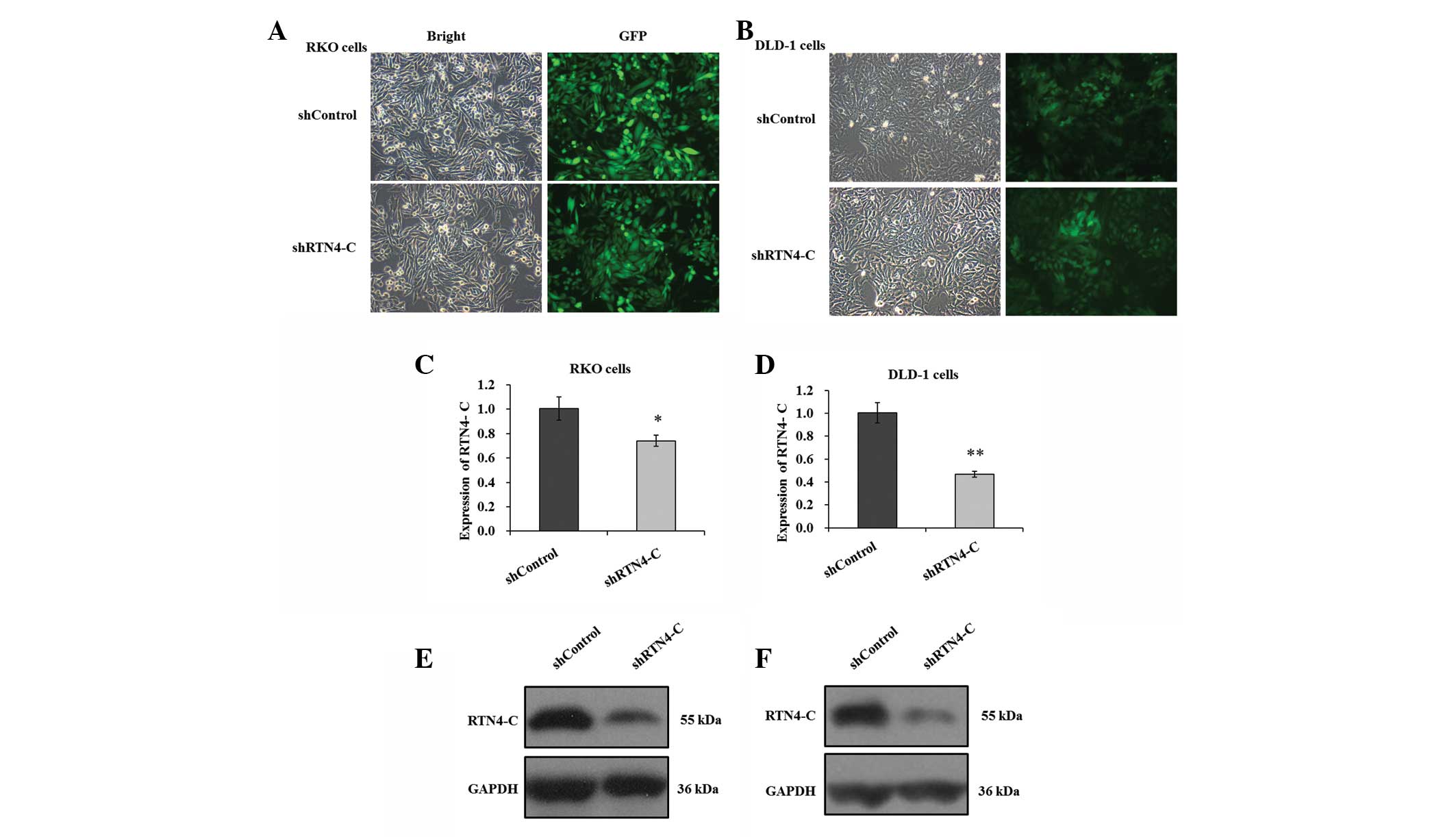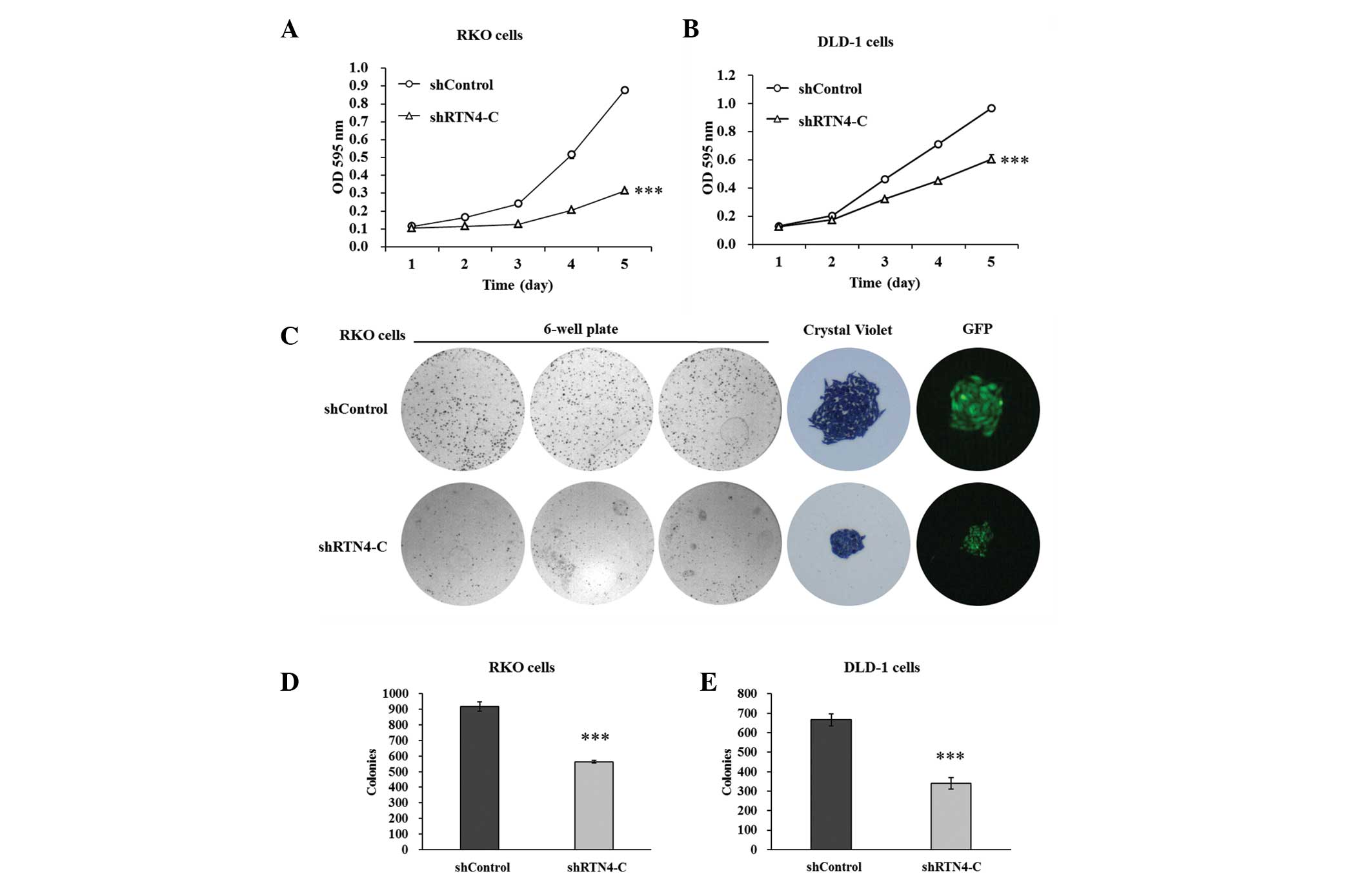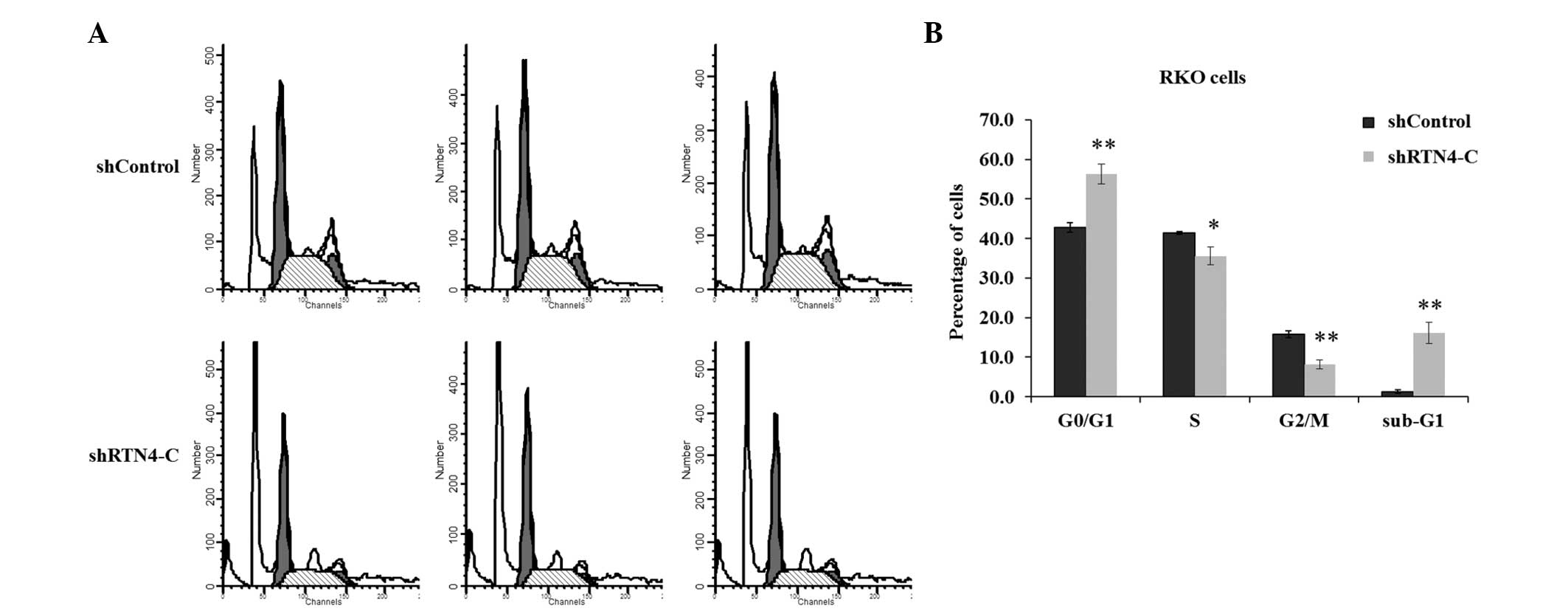Knockdown of reticulon 4C by lentivirus inhibits human colorectal cancer cell growth
- Authors:
- Published online on: March 31, 2015 https://doi.org/10.3892/mmr.2015.3569
- Pages: 2063-2067
Abstract
Introduction
Colorectal cancer is a cancer of the cells lining the colorectal epithelium and has been identified as the third most common type of cancer worldwide (1,2). It is caused by a combination of a variety of factors, including diet, genetic mutations in several different loci, and reproductive or exogenous hormone use (3). Colorectal cancer is characterized by high cell motility and metastatic potential. Metastases from the cancer, rather than the primary tumors, were observed to be the main causes of mortality (4). To prevent further deterioration, current therapies for colorectal cancer at different stages concentrate on fluorouracil plus leucovorin based conventional chemotherapeutics; however, these are accompanied by negative side effects, high recurrence rates of >50% and high costs (5). At present, the underlying molecular mechanisms to suppress human colorectal cancer development are poorly understood. Therefore, developing novel genetic therapeutic targets for the potential treatment of colorectal cancer is urgently required.
Reticulons (RTNs) have been identified as endoplasmic reticulum integral membrane proteins involved in multiple apoptotic signaling pathways (6). The family comprises four paralogs termed RTN1, RTN2, RTN3 and RTN4 (7). Previous studies have revealed that overexpression of RTN3 may induce cell apoptosis in normal HeLa cells via ectopic overexpression of Bcl-2 (8). A transcript variant 3 of RTN4 termed RTN4-C is highly expressed in the HEK293 human embryonic kidney cell line and was observed to induce cell apoptosis through the c-Jun N-terminal kinase-c-Jun signaling pathway (9). Additionally, RTN4-C inhibited the growth of SMMC7721 hepatocellular carcinoma cells via inducing apoptosis (10). However, the functional role of RTN4-C in colorectal cancer remains to be elucidated and requires further investigation.
To determine the role of RTN4-C in colorectal cancer, and potentially identify a novel target for anti-tumor therapy, the expression levels of RTN4-C were detected in multiple colorectal cancer cell lines: SW480, SW620, RKO, DLD-1, HCT116 and HT-29. Subsequently, lentivirus-mediated short hairpin RNA (shRNA) was adopted to target RTN4-C in colorectal cancer cells. Proliferation, colony formation and cell cycle assays were also conducted.
Materials and methods
Cell culture
SW480, SW620, RKO, DLD-1, HCT116, HT-29 human colorectal cancer cell lines and the HEK293T human embryonic kidney cell line were purchased from the Cell Bank of the Chinese Academy of Sciences (Shanghai, China). SW480, SW620, RKO and DLD-1 cells were cultured in RPMI-1640 (Gibco-BRL, Grand Island, NY, USA) containing 10% fetal bovine serum (FBS; Hyclone, Logan, UT, USA). HCT116 and HT-29 cells were cultured in McCoys 5A medium (Sigma-Aldrich, Poole, UK) supplemented with 10% FBS. HEK293T cells were maintained in Dulbecco’s modified Eagle’s medium (Hyclone) supplemented with 10% FBS. All cells were maintained in a humidified incubator with 5% CO2.
Construction of RTN4-C shRNA-expressing lentivirus
The cDNA sequence of RTN4-C was obtained from NCBI (GenBank, NM_007008.2). Sequence-specific knockdown of RTN4-C was induced with an shRNA with the following sequence: 5′-CCGG GCTATATCTGAGGAGTTGGTTCTCGAGAACCAACTCC TCAGATATAGCTTTTTTG-3′. The non-silencing shRNA had the following sequence: 5′-CCGGCCAAGGAAGTGCAATTGCATACTCGAGTATGCAATTGCACTTCCTTGGTTTTTTG -3′ and was used as a control. The shRNAs were purchased from Shanghai Hollybio (Shanghai, China). The two synthesized shRNAs were ligated into the pFH-L vector (Shanghai Hollybio, Shanghai, China) containing a green fluorescent protein (GFP) reporter driven by the cauliflower mosaic virus 35S promoter. The generated plasmids were transfected into HEK293T cells with the packaging vectors pVSVG-I and pCMVΔR8.92 (Shanghai Hollybio) using Lipofectamine 2000® (Invitrogen Life Technologies, Carlsbad, CA, USA) according to the manufacturer’s instructions. For lentivirus transfection, RKO and DLD-1 cells were cultured in 6-well plates at a density of 5×104 cells/well and transfected with lentiviruses (shRTN4 or shControl) at a multiplicity of transfection of 20, respectively. Transfection efficiency was determined by counting GFP-expressing cells under a fluorescence microscope (Olympus Corporation, Tokyo, Japan) 96 h after transfection.
Reverse transcription-quantitative polymerase chain reaction (RT-qPCR)
The RT-qPCR experiment was conducted to elucidate RTN4-C gene expression in the SW480, SW620, RKO, DLD-1, HCT116 and HT-29 colorectal cancer cell lines. In addition, it was performed to detect the knockdown efficiency of the RTN4-C gene in cells transfected with shControl or shRTN4, RT-qPCR was performed following transfection for 5 days. TRIzol reagent (Invitrogen Life Technologies) was used to extract the total RNA of the cultured cells. The primers sequences used were as follows: Forward 5′-CTCCTCTGGTCTCGTCCTC-3′ and reverse 5′-GTCCTCGTCCTCCTCTTCC-3′ for RTN4-C; and forward 5′-GTGGACATCCGCAAAGAC-3′ and reverse 5′-AAAGGGTGTAACGCAACTA-3′ for β-actin. Fold changes in expression were calculated using the 2−ΔΔCt method.
Western blot analysis
Following transfection for 5 days, RKO and DLD-1 cells were lysed in 2X SDS sample buffer (10 mM EDTA, 4% SDS and 10% Glycine in 100 mM Tris-HCl buffer, pH 6.8) for 1 h at 4°C. Equal quantities of proteins (30 µg) were loaded and separated on 10% SDS-PAGE gels and transferred onto polyvinylidene difluoride membranes (Millipore, Bedford, MA, USA). Following blocking with 5% skimmed milk, the membranes were exposed to the primary antibodies RTN4-C (ab47085, 1:500 dilution; Abcam, Cambridge, MA, USA) and mouse monoclonal GAPDH (sc-32233, 1:3,000; Santa Cruz Biotechnology, Inc., Santa Cruz, CA, USA) overnight at 4°C. Following incubation with goat anti-rabbit horseradish peroxidase-conjugated secondary antibody (sc-2054, 1:5,000; Santa Cruz Biotechnology, Inc.) for 1 h at room temperature, the expression of the target proteins were visualized with chemiluminescence reagents (ECL kit; Amersham Pharmacia Biotech, Amersham, UK). Bands were analyzed using the Imagequant densitometric scanner (Molecular Dynamics, Sunnyvale, CA, USA).
MTT proliferation assay
To detect the effect on proliferation of RKO and DLD-1 cells transfected by shRTN4 or shControl, an MTT assay was conducted. Lentivirus-transduced RKO and DLD-1 cells were reseeded in 96-well plates at a density of 2×103 cells/well, respectively. Viable cell numbers were determined following seeding for 1, 2, 3, 4 and 5 days. A total of 10 µl 3-(4,5-dimethylthiazol-2-yl)-2,5-diphenyltetrazolium bromide solution was added to each well. Following incubation for 3 h, 100 µl acidic isopropanol containing 10% SDS, 5% isopropanol and 0.01 mol/l HCl was added into each well to dissolve the formazan crystals. Finally, the absorbance at 595 nm was recorded using the Shimadzu UV-1603 spectrophotometer (Shimadzu, Kyoto, Japan).
Plate colony formation assay
Lentivirus-transduced RKO and DLD-1 cells were cultured in 6-well plates at a density of 400 cells/well. The medium was changed regularly. After 8 days of culture, the adherent cells were washed twice with phosphate-buffered saline and fixed with 4% paraformaldehyde for 30 min at room temperature. The fixed cells were then stained with crystal violet (Beyotime Institute of Biotechnology, Haimen, China). The number of colonies (>50 cells/colony) were observed and counted using a fluorescence microscope (Olympus BX50; Olympus, Tokyo, Japan).
Cell cycle analysis
The RKO cells transfected with shRTN4 or shControl were seeded at 5×104 cells/dish in 6-cm dishes and incubated for 72 h. Cell cycle progression was subsequently monitored using a flow cytometer (Navios; Beckman Coulter, Miami, FL, USA) and cell cycle analysis kit (C1052; Beyotime Institute of Biotechnology) according to the manufacturer’s instructions.
Statistical analysis
All data are expressed as the mean ± standard deviation from three independent experiments. Student’s t-test was performed for statistical analysis. Statistical analyses were conducted using SPSS version 19.0 (IBM, Armonk, NY, USA). P<0.05 was considered to indicate a statistically significant difference.
Results
Differential transcription and translation of RTN4-C in six colorectal cancer cell lines
Firstly, RT-qPCR was used to analyze RTN4-C expression at the transcriptional level in six colorectal cell lines SW480, SW620, RKO, DLD-1, HCT116, and HT-29 (Fig. 1A). As a result, the SW620 cells exhibited the highest expression level of RTN4-C among these cells, while RKO cells exhibited the lowest. The SW480, DLD-1, HCT116 and HT-29 cell lines exhibited relatively high expression patterns of RTN4-C compared with RKO cells. The translational levels of RTN4-C in these six cell lines were detected using western blot analysis. As shown in Fig. 1B, SW480, DLD-1, HCT-116 and HT-29 cells exhibited high expression levels of RTN4-C protein. The RKO cells, which exhibited the lowest expression levels of RTN4-C mRNA expression also revealed the lowest translational pattern. However, SW620 cells with the highest transcriptional level of RTN4-C exhibited a relatively low protein expression. To investigate the biological function of RTN4-C in colorectal cancer, the DLD-1 and RKO cell lines with relatively high and low RTN4-C expression patterns were selected.
Successful depletion of RTN4-C in DLD-1 and RKO cells by lentivirus-derived RNA interference (RNAi)
RKO and DLD-1 cells transfected with recombinant lentiviruses harboring shRTN4 or shControl were used to assess the effects of RTN4-C knockdown on colorectal cancer growth. As shown in Fig. 2A and B, the transfection rates in RKO and DLD-1 cells were >80%, as detected by GFP-fluorescence. The mRNA levels of RTN4-C were significantly decreased in the two cell lines following shRTN4 transfection compared with shControl, as measured by RT-qPCR (Fig. 2C and D). The knockdown efficiency of RTN4-C was 26.2 and 53.2% in RKO and DLD-1 cells, respectively. The endogenous RTN4-C protein level was estimated in the two cell lines using western blot analysis. This revealed that the expression levels of RTN4-C were reduced markedly in shRTN4-transfected RKO and DLD-1 cells in comparison with shControl (Fig. 2E and F). In conclusion, it was inferred that RTN4-C depletion was successfully introduced in DLD-1 and RKO cells via shRTN4 transfection.
Cell proliferation and colony formation of DLD-1 and RKO cells are inhibited by RTN4-C downregulation
To evaluate whether the proliferation of RKO and DLD-1 cells was affected by RTN4-C downregulation, an MTT assay was performed. Figure 3A and B show that the proliferation rates were decreased markedly in shRTN4-transfected RKO and DLD-1 cells relative to the shControl. The proliferation of shRTN4-transfected RKO cells was suppressed by 60 and 64% at days 4 and 5 compared with the shControl. The proliferation of DLD-1 cells was reduced by 36 and 37% at days 4 and 5, respectively, in the shRTN4 group compared with the shControl group.
In addition, a colony formation assay was conducted to determine the effect of RTN4-C on the in vitro tumorigenicity of colorectal cancer cells. The number of colonies was fewer and the size of each colony was markedly smaller in the shRTN4 groups compared with the shControl groups (Fig. 3C). Total colony numbers were reduced significantly as indicated in Fig. 3D and E. There were 564±28 colonies formed of shRTN4-transfected RKO cells, while 917±10 colonies of the shControl cells formed. There were 340±18 colonies formed of shRTN4-transfected DLD-1 cells, while there were 666±30 colonies in the shControl groups. These results demonstrated that RTN4-C knockdown may inhibit colorectal cancer cell proliferation and colony formation.
RTN4-C knockdown blocks cell cycle progression in RKO cells
To examine the mechanisms of cell growth inhibition by lentivirus-mediated RTN4-C knockdown, the cell cycle progression of RKO cells was determined using flow cytometry (Fig. 4A). As shown in Fig. 4B, cell numbers in shRTN4 groups were significantly increased in the G0/G1 phase and the sub-G1 phase representing apoptotic cells, compared with those in the shControl groups. The percentage of cells was increased by ~24 or ~92% in the G0/G1 phase or the sub-G1 phase, respectively, following shRTN4 transfection. Whereas the percentage of cells was decreased by 14 or 48% in the S phase or the G2/M phase following shRTN4 transfection. Knockdown of RTN4-C may inhibit colorectal cancer cell growth possibly via induction of cell cycle arrest and apoptosis.
Discussion
Colorectal cancer is regarded as one of the most common malignancies and it is difficult to treat (11,12). Previous studies have indicated that >55,000 mortalities occur due to metastatic colorectal cancer annually in the United States alone (13). To gain insight into the biological function of RTN4-C in colorectal cancer, lentivirus-based RTN4-C knockdown in RKO and DLD-1 colorectal cancer cells were constructed and further investigated. The results revealed that the cell proliferation and colony formation were restrained in shRTN4 transfected RKO and DLD-1 cells.
Several previous studies have reported that changes in cell cycle distribution contribute to cell proliferation inhibition. Notably, microRNA-125b arrested the cell cycle at the G1 to S transition to prevent cell proliferation and metastasis in human liver cancer (14). Nemo-like kinase expression knockdown blocks the G0/G1 phase to S phase transition to inhibit human adenosquamous carcinoma cells CAL-27 proliferation and colony formation (15). During the present study, knockdown of RTN4 caused a decrease in the percentage of cells in S phase and G2/M phase, but resulted in an increase of cells in G0/G1 phase, in particular there was an increased number of apoptotic cells, as indicated by an increase of cells in sub-G1 phase, which suggests that RTN4-C may regulate G0/G1 to S phase transition and inhibit cell apoptosis. Nevertheless, cell apoptosis was promoted in SMMC7721 hepatocellular carcinoma cells with an increased level of RTN4-C (10). Additionally, Chen et al (9) reported that RTN4-C induced HEK293 cell apoptosis through its involvement in the c-Jun N-terminal kinase-c-Jun pathway. These studies suggest that RTN4-C may function differentially in cancer cell growth and apoptosis in various human organs. In the present study, RTN4-C knockdown may have altered gene expression to directly or indirectly activate the cell apoptosis pathway in colorectal cancer cells. In conclusion, RTN4-C knockdown may induce cell apoptosis and block cell cycle progression at the G0/G1 phase to suppress cell proliferation and colony formation in colorectal cancer cells. However, the altered gene expression and the activated apoptosis signaling pathway remain to be elucidated and require further study.
It is well-established that tumor metastasis is facilitated by cell proliferative activity (16). Therefore, controlling cell proliferation may contribute to the prevention of tumor development. The present study demonstrated that knockdown of RTN4-C by RNAi resulted in a significant inhibition of colorectal cancer cell growth via induction of G0/G1 phase cell cycle arrest and apoptosis. The present study improves the understanding of RTN4-C function in colorectal cancer and may aid in the development of a novel therapeutic approach.
Acknowledgments
The present study was supported by the Research Fund of the Science and Technology Commission of Shanghai Municipality (grant no. 12ZR1418000).
References
|
Nasrallah A, Saykali B, Al Dimassi S, Khoury N, Hanna S and El-Sibai M: Effect of StarD13 on colorectal cancer proliferation, motility and invasion. Oncol Rep. 31:505–515. 2014. | |
|
Mathis KL and Nelson H: Controversies in laparoscopy for colon and rectal cancer. Surg Oncol Clin N Am. 23:35–47. 2014. View Article : Google Scholar | |
|
Watson AJ and Collins PD: Colon cancer: a civilization disorder. Dig Dis. 29:222–228. 2011. View Article : Google Scholar : PubMed/NCBI | |
|
Chambers AF, Groom AC and MacDonald IC: Metastasis: dissemination and growth of cancer cells in metastatic sites. Nat Rev Cancer. 2:563–572. 2002. View Article : Google Scholar : PubMed/NCBI | |
|
Shakibaei M, Buhrmann C, Kraehe P, Shayan P, Lueders C and Goel A: Curcumin chemosensitizes 5-fluorouracil resistant mmr-deficient human colon cancer cells in high density cultures. PLoS One. 9:e853972014. View Article : Google Scholar : PubMed/NCBI | |
|
Chiurchiu V, Maccarrone M and Orlacchio A: The role of reticulons in neurodegenerative diseases. Neuromolecular Med. 16:3–15. 2014. View Article : Google Scholar : | |
|
Diekmann H, Klinger M, Oertle T, et al: Analysis of the reticulon gene family demonstrates the absence of the neurite growth inhibitor Nogo-A in fish. Mol Biol Evol. 22:1635–1648. 2005. View Article : Google Scholar : PubMed/NCBI | |
|
Zhu L, Xiang R, Dong W, Liu Y and Qi Y: Anti-apoptotic activity of Bcl-2 is enhanced by its interaction with RTN3. Cell Biol Int. 31:825–830. 2007. View Article : Google Scholar : PubMed/NCBI | |
|
Chen Y, Tang X, Cao X, Chen H and Zhang X: Human Nogo-C overexpression induces HEK293 cell apoptosis via a mechanism that involves JNK-c-Jun pathway. Biochem Biophys Res Commun. 348:923–928. 2006. View Article : Google Scholar : PubMed/NCBI | |
|
Chen YC, Lu DD, Cao XR and Zhang XR: RTN4-C gene expression in hepatocellular carcinoma and its influence on SMMC7721 cell growth and apoptosis. Yi Chuan Xue Bao. 32:891–897. 2005.PubMed/NCBI | |
|
Murray GI, Duncan ME, O’Neil P, Melvin WT and Fothergill JE: Matrix metalloproteinase-1 is associated with poor prognosis in colorectal cancer. Nat Med. 2:461–462. 1996. View Article : Google Scholar : PubMed/NCBI | |
|
Saltz LB, Cox JV, Blanke C, et al: Irinotecan plus fluorouracil and leucovorin for metastatic colorectal cancer Irinotecan Study Group. N Engl J Med. 343:905–914. 2000. View Article : Google Scholar : PubMed/NCBI | |
|
Halama N, Michel S, Kloor M, et al: Localization and density of immune cells in the invasive margin of human colorectal cancer liver metastases are prognostic for response to chemotherapy. Cancer Res. 71:5670–5677. 2011. View Article : Google Scholar : PubMed/NCBI | |
|
Liang L, Wong CM, Ying Q, et al: MicroRNA. 125b suppressesed human liver cancer cell proliferation and metastasis by directly targeting oncogene LIN28B2. Hepatology. 52:1731–1740. 2010. View Article : Google Scholar : PubMed/NCBI | |
|
Zhang B, Li KY, Chen HY, et al: Lentivirus-based RNA silencing of nemo-like kinase (NLK) inhibits the CAL 27 human adenosquamos carcinoma cells proliferation and blocks G0/G1 phase to S phase. Int J Med Sci. 10:1301–1306. 2013. View Article : Google Scholar : PubMed/NCBI | |
|
Zhao H, Ho PC, Lo YH, et al: Interaction of proliferation cell nuclear antigen (PCNA) with c-Abl in cell proliferation and response to DNA damages in breast cancer. PloS One. 7:e294162012. View Article : Google Scholar : PubMed/NCBI |













